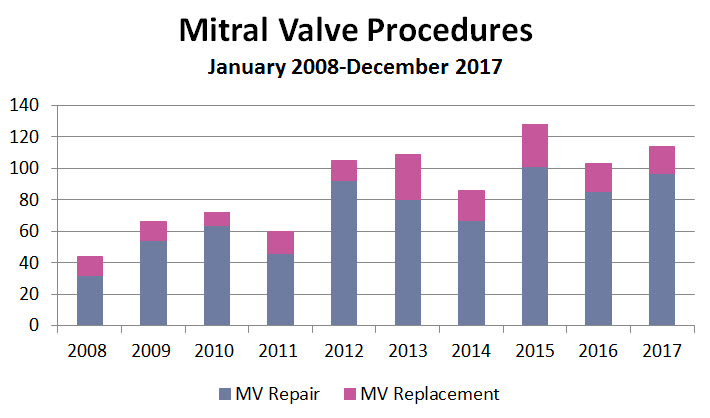Mitral Valve | Overview
At Boston Children’s, we see a wide range of congenital mitral valve diseases. In some cases, lesions are identified before or right after birth (including mitral stenosis or atresia associated with HLHS); other types of mitral valve disease are identified in the infant or childhood years (such as double orifice mitral valve, cleft mitral valve, supra-mitral ring, rheumatic heart disease and atrioventricular (AV) canal defects).
Many patients with these complex conditions have often had prior surgery and are left with residual mitral stenosis and or other problems that require additional surgery.
Mitral valve repair vs. replacement
At Boston Children’s, we feel it is best to repair rather than to replace diseased mitral valve.Over the past decade, we have been analyzing our valve repair techniques and are developing solutions to repair mitral valves in a way that will keep the other parts of the heart strong and healthy.

Mitral Valve Surgical volume and results
Timing for surgery
For many routine procedures on the mitral valve, most cardiologists and surgeons agree that it is best to repair the valve after the first few months of life—a time when the infant has difficultly feeding and gaining weight. However, we generally do not wait a pre-determined amount of time before intervening—we will intervene to help a child grow and gain wait, and we will intervene despite a child’s troubles with growth and weight ga
Factors such as heart function, associated heart valve disease and associated arrhythmias are considered for some of the more complex types of mitral valve disease that are associated with other congenital heart disease.
Fetal and infant catheter-based intervention for mitral valve disease
Some patients with mitral stenosis may benefit from a catheter-based procedure called “mitral valve balloon dilation.” To make the best decision for these patients, a team of cardiologists and surgeons evaluate the pros and cons of cateterization-based balloon dilation vs. surgery.
Our experience
At Boston Children’s, we have extensive experience repairing the mitral valve. Between 2005 and 2012, we performed nearly 800 operations on the mitral valve. Many of these first-time operations on the mitral valve were for AV canal repairs, while the others were associated with other more complex mitral valve disease. More than 90 percent of all patients coming for mitral valve surgery had a mitral valve repair rather than replacement.
Unique situations requiring novel solutions
Patients with extreme forms of mitral valve disease are often referred to Boston Children’s. Many of these patients have severe types of cardiac disease. Treating these patients is often complicated, requiring unique solutions to difficult problems. Our cardiologists and surgeons are dedicated to finding the right solutions.
Mitral Valve clinical studies & trials
We are currently evaluating the short- and long-term effects of using different types of patch material to repair deficient mitral valves—those valves that require additional leaflet tissue to facilitate appropriate valve coaptation.
Conditions associated with mitral valve disease
Primary AV canal defects:
- partial, primum AV canal defect
- complete AV canal defect (CAVC)
Mitral regurgitation or stenosis associated with:
- a prior AV canal repair
- connective tissue disorder
- mitral valve cleft
Congenital Mitral Stenosis
- Shone's complex
- HLHS (Mitral atresia and mitral stenosis)
Endocarditis involving mitral valve
